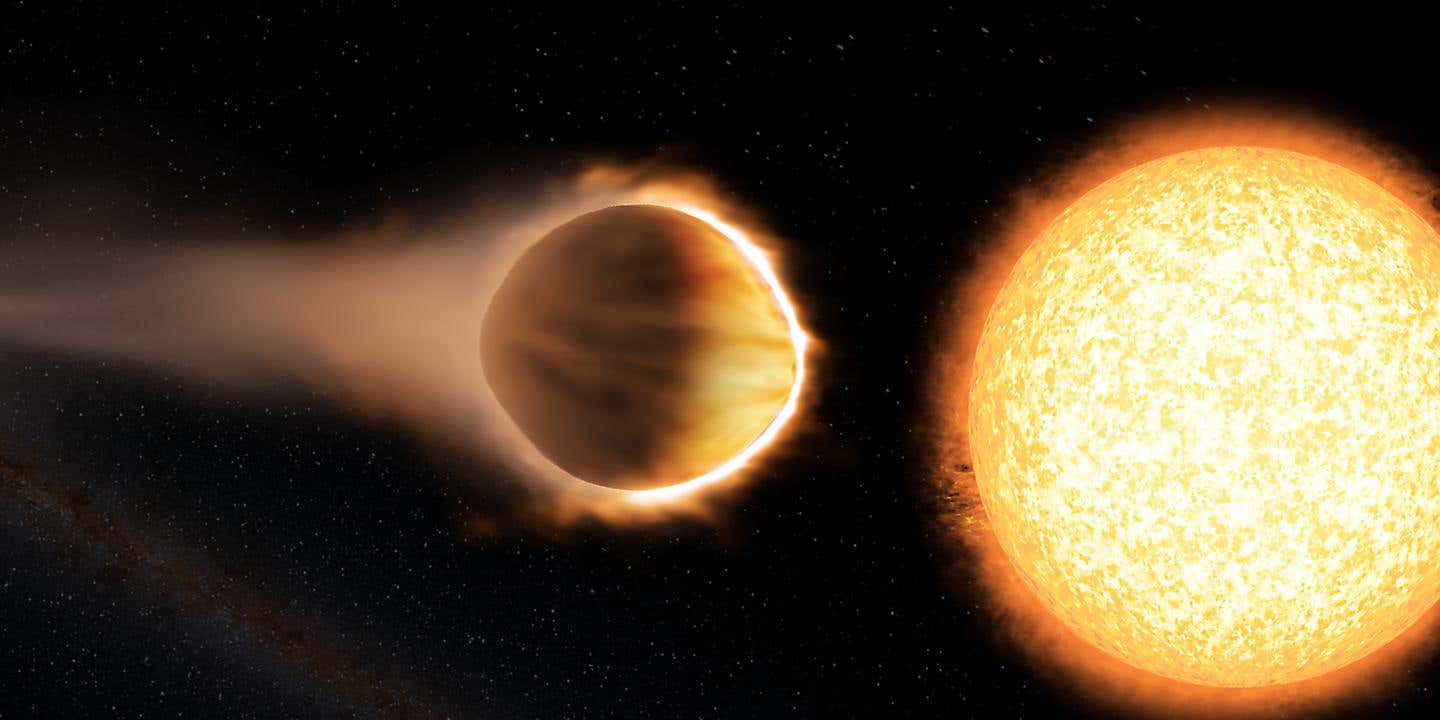Astronomers capture first 3D view of an exoplanet’s atmosphere and climate
Scientists map the first 3D structure of an exoplanet’s atmosphere, revealing extreme winds and unexpected chemical patterns in a distant gas giant.

Artist’s concept of the exoplanet WASP-121 b, also known as Tylos. (CREDIT: Engine House VFX, At-Bristol Science Centre, University of Exeter)
Astronomers have achieved a breakthrough in planetary science, revealing the complex weather of a distant gas giant with unprecedented detail. By mapping the three-dimensional structure of the planet’s atmosphere, they uncovered extreme winds, vertical circulation patterns, and chemical compositions unlike anything seen before.
The planet, known as WASP-121b or Tylos, is an ultra-hot Jupiter orbiting its star just 900 light-years away in the constellation Puppis. With a year that lasts only 30 Earth hours, this planet is locked in a tidal embrace, with one side constantly facing the star and the other in perpetual darkness.
The result is a world of atmospheric extremes, where scorching temperatures and high-speed winds sculpt an alien climate unlike anything in our solar system.
A Supercharged Atmosphere in Motion
For the first time, scientists have traced the winds in separate layers of an exoplanet’s atmosphere, uncovering a vertical circulation pattern that defies conventional models. The research revealed two distinct atmospheric flows: a powerful jet stream moving material around the equator and a deeper, unilateral flow carrying gas from the scorching day side to the cooler night side.
“This planet’s atmosphere behaves in ways that challenge our understanding of how weather works—not just on Earth, but on all planets,” says Julia Victoria Seidel, lead author of the study and a researcher at the European Southern Observatory (ESO) in Chile. “It feels like something out of science fiction.”
The planet’s equatorial jet stream spans half of its circumference, gaining speed as it whips across the day side before violently churning through the upper atmosphere. Even the strongest hurricanes in our solar system seem mild in comparison.
Below this jet, a separate current moves gases from the intensely heated day side to the cooler, space-facing hemisphere. This unique circulation pattern is unlike anything observed before.
Unveiling the 3D Climate of an Alien World
To map these atmospheric layers, the research team used the ESPRESSO instrument on ESO’s Very Large Telescope (VLT), combining the power of all four telescope units into a single signal. This technique increased the light collected, allowing astronomers to detect fainter details in the planet’s atmosphere.
Related Stories
By observing the planet as it passed in front of its host star, the team analyzed the absorption patterns of different chemical elements, tracking their movement through various atmospheric layers. The findings included iron, sodium, and hydrogen, which revealed wind speeds and flow directions in deep, mid, and upper layers, respectively.
“The VLT enabled us to probe three different layers of the exoplanet’s atmosphere in one fell swoop,” says Leonardo A. dos Santos, an assistant astronomer at the Space Telescope Science Institute in the United States. “This kind of observation is very challenging to do with space telescopes, highlighting the importance of ground-based research on exoplanets.”
Further analysis revealed a surprising presence of titanium just below the jet stream. Previously, this element had been undetected, likely hidden deep within the planet’s atmosphere.
The unexpected discovery, detailed in a companion study, suggests that atmospheric composition can shift dramatically between different layers, influencing weather patterns in ways that remain poorly understood.
The Future of Exoplanetary Atmosphere Research
Current global circulation models struggle to replicate the observed wind patterns, indicating a gap between theoretical predictions and real-world data. The findings provide a crucial testbed for refining atmospheric models and understanding climate processes beyond our solar system.
Future telescopes will push this research further. The Extremely Large Telescope (ELT), under construction in Chile’s Atacama Desert, will play a key role in uncovering more details about exoplanet atmospheres. With its ANDES instrument, the ELT will enable even more precise measurements of chemical compositions and weather systems on distant worlds.
“The ELT will be a game-changer for studying exoplanet atmospheres,” says Bibiana Prinoth, a PhD student at Lund University and co-author of the study. “This experience makes me feel like we’re on the verge of uncovering incredible things we can only dream about now.”
The ability to track atmospheric circulation on planets hundreds of light-years away marks a new era in exoplanet science. By mapping the complex climate of ultra-hot Jupiters, astronomers move closer to understanding the fundamental principles of planetary atmospheres, paving the way for future discoveries of Earth-like worlds.
Note: Materials provided above by The Brighter Side of News. Content may be edited for style and length.
Like these kind of feel good stories? Get The Brighter Side of News' newsletter.
Joshua Shavit
Science & Technology Writer | AI and Robotics Reporter
Joshua Shavit is a Los Angeles-based science and technology writer with a passion for exploring the breakthroughs shaping the future. As a contributor to The Brighter Side of News, he focuses on positive and transformative advancements in AI, technology, physics, engineering, robotics and space science. Joshua is currently working towards a Bachelor of Science in Business Administration at the University of California, Berkeley. He combines his academic background with a talent for storytelling, making complex scientific discoveries engaging and accessible. His work highlights the innovators behind the ideas, bringing readers closer to the people driving progress.



